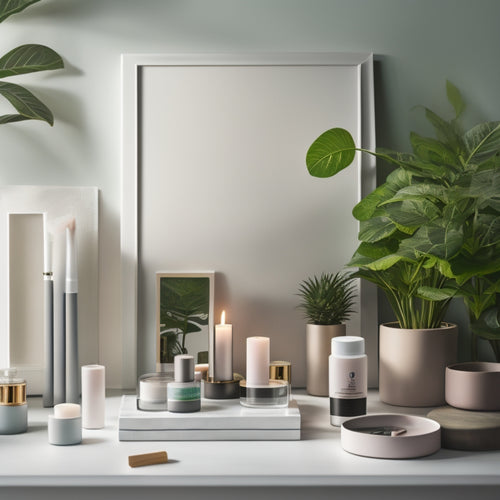
Empower Your Arts: Equity Resources Unveiled
Share
The Empower Your Arts initiative introduces a wide range of equity resources to dismantle systemic barriers and foster a more inclusive creative landscape in dance and theatre. This includes resources for empowering artistic expression, amplifying marginalized voices, and building inclusive communities. The initiative provides tools to challenge dominant narratives, amplify underrepresented voices, and promote equity and belonging. By centering marginalized voices and valuing diversity, the initiative aims to enrich the fabric of dance and theatre. As you explore these resources, discover how you can create a more just and inclusive environment that truly celebrates the arts.
Key Takeaways
• Empower artistic expression with DisruptTexts, a resource challenging dominant narratives and promoting anti-racist and anti-oppressive values.
• Amplify marginalized voices through a database of BIPOC designers, engineers, and directors, showcasing their innovative approaches and perspectives.
• Foster inclusive communities by valuing diversity, addressing systemic inequalities, and promoting cross-cultural understanding and empowerment.
• Explore innovative storytelling and design approaches that challenge dominant narratives and promote diverse representation and exploration of new perspectives.
• Access a platform that uplifts narratives from underrepresented communities, providing a space for authentic expression and promoting equity and cultural heritage.
Empowering Artistic Expression
The equity resources for dance and theatre, including DisruptTexts, Anti-Racist and Anti-Oppressive resources, and the Database of BIPOC Designers, Engineers, and Directors, empower artistic expression by providing tools and frameworks for creators to challenge dominant narratives and amplify marginalized voices.
These resources foster creativity by offering innovative approaches to storytelling, character development, and scenic design. By promoting diversity, they encourage artists to explore new perspectives and challenge the status quo. This, in turn, enables the creation of more inclusive and representative works that resonate with diverse audiences.
Amplifying Marginalized Voices
By centering marginalized voices, artists can tap into the rich cultural heritage and diverse experiences that have historically been silenced or erased, thereby enriching the fabric of dance and theatre.
This amplification of marginalized voices is vital in breaking down barriers and promoting equity in the arts.
Centering perspectives and uplifting narratives from underrepresented communities can foster a more inclusive and diverse artistic landscape.
Advocating representation and sharing stories from marginalized voices can also challenge dominant narratives and provide a platform for marginalized artists to express themselves authentically.
Building Inclusive Communities
One essential step towards achieving equity in the arts is to cultivate inclusive communities that value diversity, promote belonging, and foster a sense of responsibility towards creating a fair and just environment. Building inclusive communities requires intentional community engagement and diversity celebration.
This involves creating spaces where diverse voices are heard, and perspectives are valued. It also means acknowledging and addressing systemic inequalities and biases that hinder inclusivity. By doing so, we can foster a sense of belonging, promote cross-cultural understanding, and empower marginalized voices. This, in turn, can lead to a more equitable and just arts ecosystem.
Frequently Asked Questions
How Do I Ensure Accessibility in My Online Performances?
'As you step into the virtual spotlight, keep in mind that accessibility is crucial for creating a truly inclusive experience. Guarantee your online performances shine by incorporating Closed Captions and Audio Descriptions, illuminating the path for all audiences to engage with your art.'
What Are Some Inclusive Language Practices for My Marketing Materials?
When crafting marketing materials, employ inclusive language practices by considering cultural nuances and linguistic barriers. Use clear, concise language, avoiding idioms and colloquialisms that may alienate diverse audiences, and provide translations or multilingual support to guarantee accessibility.
Can You Recommend Resources for Addressing Microaggressions in Rehearsals?
To address microaggressions in rehearsals, establish clear rehearsal protocols and recognize microaggression triggers. Utilize resources like Anti-Racist Theatre Teaching Resources and Decolonizing the Music Room to create a safe and inclusive environment, promoting open communication and empathy.
How Can I Create a Safe Space for Artists With Disabilities?
"Did you know that 1 in 5 people have a disability? To create a safe space for artists with disabilities, prioritize Disability Advocacy and Inclusive Feedback, ensuring equal opportunities and accessibility, fostering a culture of empathy and understanding."
What Are Some Strategies for Addressing Power Imbalances in Collaborative Projects?
To address power imbalances in collaborative projects, employ strategies like active listening, rotating leadership roles, and inclusive decision-making processes, and establish clear conflict resolution protocols to foster a culture of mutual respect and equal voice.
Related Posts
-

7 Time-Saving Hacks for Makeup Artists' Self-Care
As a makeup artist, you know the importance of self-care, but finding time for it can be a challenge. You're not alon...
-

Festive Reindeer Cross Stitch Pattern Delights Crafters
This festive reindeer cross stitch pattern, featuring Dancer, one of Santa's beloved reindeer, is a delightful treat ...
-

Unleash the Secrets of Shinobi: Genesis Manual
The Shinobi: Genesis Manual is a treasured resource for enthusiasts, offering an in-depth exploration into the intric...


